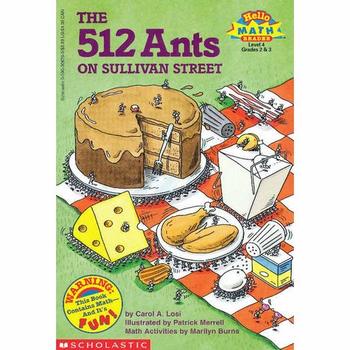Math in Literature Lesson (WITH STANDARDS) - The 512 Ants on Sullivan Street
JordanLeeTPT
7 Followers
JordanLeeTPT
7 Followers
What educators are saying
Such a great resource to help connect literacy to math. This allows students to open their thinking and understand that math is everywhere!!
Description
This great lesson plan incorporates math, reading, writing, and even science! Students will love this silly story and will see the greatness of multiplication through the foods that the sneaky ants are stealing from the picnic. A free YouTube link to the book being read aloud with pictures is also included.
*OPERATIONS & ALGEBRAIC THINKING
INCLUDED:
- Lesson Plan
- 3rd - 5th Grade Standards & Grade Level Focuses
- Could easily be altered for younger or older grade levels!
- Mathematical Ideas Throughout The Book
- Classroom Discussion (With Table)
- Extension Activity
Total Pages
8 pages
Answer Key
Included
Teaching Duration
45 minutes
Report this resource to TPT
Reported resources will be reviewed by our team. Report this resource to let us know if this resource violates TPT’s content guidelines.
Standards
to see state-specific standards (only available in the US).
CCSS3.OA.A.1
Interpret products of whole numbers, e.g., interpret 5 × 7 as the total number of objects in 5 groups of 7 objects each. For example, describe a context in which a total number of objects can be expressed as 5 × 7.
CCSS3.OA.A.3
Use multiplication and division within 100 to solve word problems in situations involving equal groups, arrays, and measurement quantities, e.g., by using drawings and equations with a symbol for the unknown number to represent the problem.
CCSS3.OA.B.5
Apply properties of operations as strategies to multiply and divide. Examples: If 6 × 4 = 24 is known, then 4 × 6 = 24 is also known. (Commutative property of multiplication.) 3 × 5 × 2 can be found by 3 × 5 = 15, then 15 × 2 = 30, or by 5 × 2 = 10, then 3 × 10 = 30. (Associative property of multiplication.) Knowing that 8 × 5 = 40 and 8 × 2 = 16, one can find 8 × 7 as 8 × (5 + 2) = (8 × 5) + (8 × 2) = 40 + 16 = 56. (Distributive property.)
CCSS4.OA.A.1
Interpret a multiplication equation as a comparison, e.g., interpret 35 = 5 × 7 as a statement that 35 is 5 times as many as 7 and 7 times as many as 5. Represent verbal statements of multiplicative comparisons as multiplication equations.
CCSS4.OA.A.2
Multiply or divide to solve word problems involving multiplicative comparison, e.g., by using drawings and equations with a symbol for the unknown number to represent the problem, distinguishing multiplicative comparison from additive comparison.


